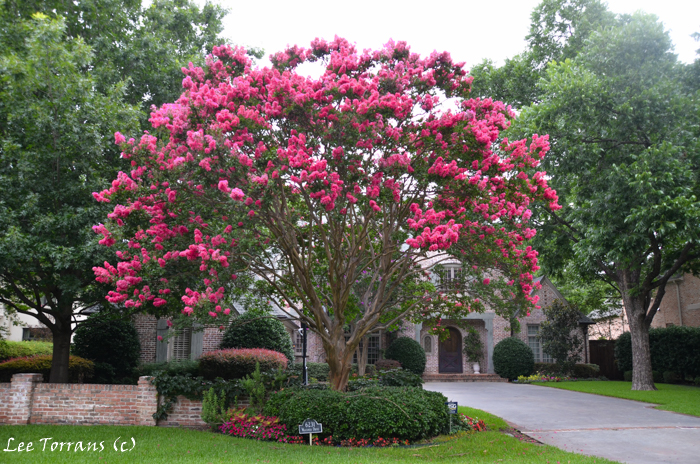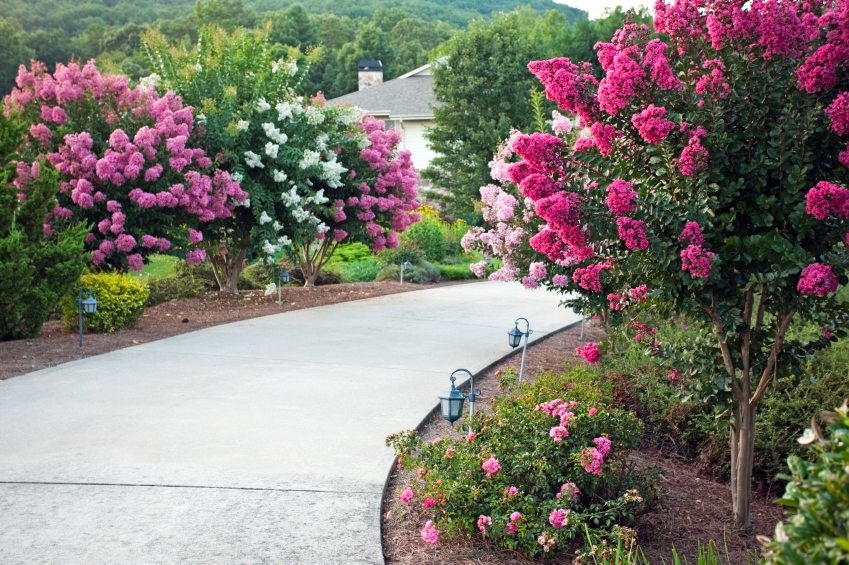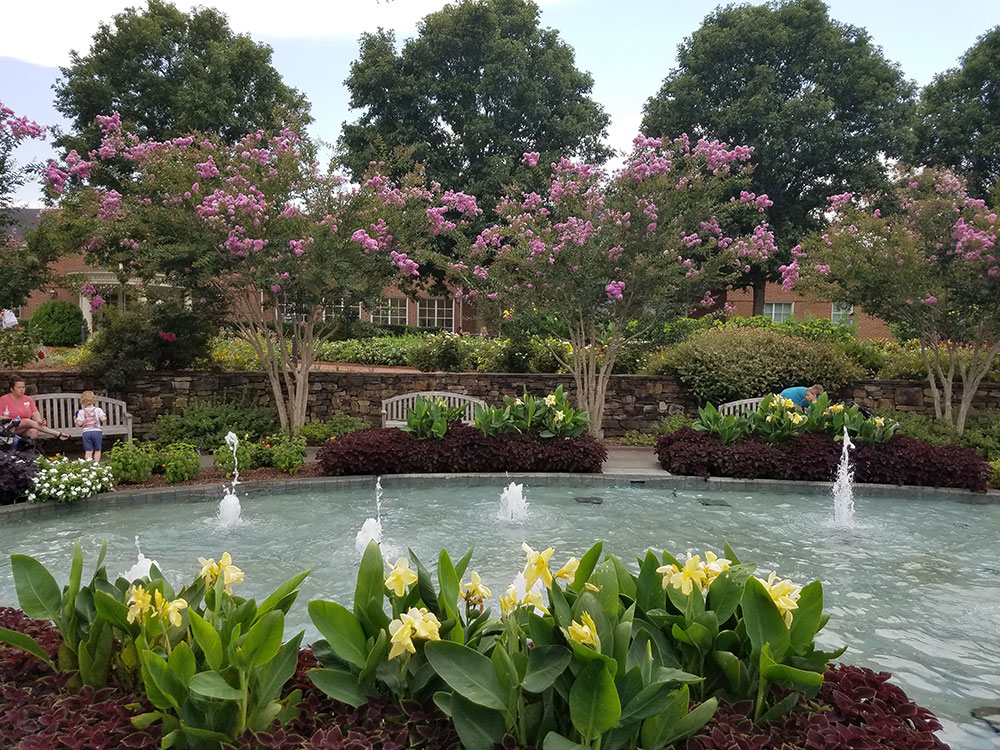
Using Crape Myrtles in Landscape Design: Transform Your Garden
Crape Myrtles add vibrant color and texture to landscape designs. They are versatile and thrive in various climates.
Crape Myrtles are popular choices for landscape design due to their striking blooms and adaptability. These deciduous shrubs or small trees produce vibrant flowers in shades of pink, red, white, and purple from summer to fall. They thrive in full sun and well-drained soil, making them ideal for gardens, parks, and urban settings.
Crape Myrtles also have attractive, peeling bark and can serve as focal points or hedges. Their drought tolerance and resistance to pests further enhance their appeal. By incorporating Crape Myrtles into your landscape, you can enjoy year-round interest and low-maintenance beauty.
Introduction To Crape Myrtles
Crape Myrtles are popular in landscape design. They offer vibrant colors and unique textures. These trees thrive in various climates and soil types.
What Are Crape Myrtles?
Crape Myrtles are deciduous trees or shrubs. They are known for their colorful blooms. They can grow up to 30 feet tall.
Their flowers come in pink, red, white, and purple. The leaves turn orange and red in the fall. Their bark peels, adding a unique texture.
- Colorful blooms
- Unique bark texture
- Fall leaf colors
History And Origin
The origin of Crape Myrtles traces back to Southeast Asia. They were brought to the United States in the 18th century. They adapted well to the southern climates.
These trees became popular in the southern United States. They are now a common sight in gardens and parks.
| Region | Introduction Period |
|---|---|
| Southeast Asia | Native |
| United States | 18th Century |

Credit: www.merrifieldgardencenter.com
Benefits Of Crape Myrtles
Crape Myrtles are wonderful additions to any landscape design. They offer numerous benefits that make them a favorite among gardeners and landscapers. Let’s explore the key benefits of using Crape Myrtles in your garden.
Aesthetic Appeal
Crape Myrtles are known for their stunning visual appeal. Their flowers bloom in vibrant colors like pink, red, white, and purple. These colors can brighten up any garden.
Their beautiful bark adds interest throughout the year. It peels away to reveal smooth, colorful layers. This makes them attractive even in winter.
They also have graceful forms that can serve as focal points. Their elegant branches create a lovely canopy, providing shade and shelter.
Low Maintenance
Crape Myrtles are very easy to care for. They require minimal pruning. Annual pruning is enough to keep them healthy and looking good.
They are also drought-tolerant. This means they need less water once established. This makes them perfect for areas with water restrictions.
They resist many common pests and diseases. This reduces the need for chemical treatments. Fewer chemicals mean a healthier garden for you and your family.
Here is a simple table summarizing the benefits:
| Benefit | Description |
|---|---|
| Aesthetic Appeal | Vibrant flowers, beautiful bark, elegant forms |
| Low Maintenance | Minimal pruning, drought-tolerant, pest-resistant |
Choosing The Right Variety
Selecting the perfect crape myrtle variety is crucial for your landscape design. Different varieties offer unique color options and growth patterns. This guide helps you pick the best one for your needs.
Color Options
Crape myrtles come in a wide range of colors. The flowers can be white, pink, red, or purple. Each color can add a unique touch to your garden.
- White: Pure and elegant, great for a clean look.
- Pink: Soft and charming, adds a gentle touch.
- Red: Bold and vibrant, perfect for a striking effect.
- Purple: Rich and regal, adds a luxurious feel.
Size And Growth Patterns
Crape myrtles vary in size and growth patterns. Some grow tall and wide, while others stay short and compact.
| Variety | Height | Width | Growth Pattern |
|---|---|---|---|
| Dwarf | 3-5 feet | 3-5 feet | Compact |
| Medium | 6-15 feet | 6-10 feet | Moderate |
| Tall | 16-25 feet | 10-20 feet | Expansive |
Choose a size that fits your garden space. Dwarf varieties work well in small gardens. Medium varieties are great for medium-sized yards. Tall varieties make a big impact in large spaces.

Credit: leeanntorrans.com
Planting Crape Myrtles
Crape Myrtles are a stunning addition to any garden. Their vibrant blooms and unique bark add beauty and interest. To enjoy their full potential, proper planting is essential. In this section, we will explore the best practices for planting Crape Myrtles, focusing on Ideal Soil Conditions and Planting Techniques.
Ideal Soil Conditions
Crape Myrtles thrive in well-drained soil. They prefer slightly acidic to neutral pH levels. Here’s a simple guide to achieving ideal soil conditions:
- Test your soil pH. Aim for a pH between 5.5 and 7.0.
- Amend the soil if needed. Add lime to raise pH or sulfur to lower it.
- Ensure good drainage. Avoid areas where water tends to pool.
- Incorporate organic matter. Mix compost or aged manure into the soil.
Proper soil preparation ensures healthy root growth and vibrant blooms.
Planting Techniques
Follow these steps for successful planting:
- Choose the right spot: Select a location with full sun exposure. Crape Myrtles need at least 6 hours of sunlight daily.
- Dig the hole: Dig a hole twice as wide and as deep as the root ball.
- Prepare the plant: Remove the plant from its container. Gently loosen the roots.
- Place the plant: Position the plant in the center of the hole. Ensure the root flare is level with the soil surface.
- Backfill the hole: Fill the hole with soil. Firm the soil around the roots to remove air pockets.
- Water thoroughly: Water the plant deeply. This helps settle the soil and establish roots.
- Mulch: Apply a 2-3 inch layer of mulch around the base. Keep mulch away from the trunk to prevent rot.
Proper planting techniques help Crape Myrtles establish quickly and grow strong.
By following these guidelines, you can enjoy beautiful Crape Myrtles in your landscape. Their bright blooms and elegant structure will enhance your garden.
Caring For Crape Myrtles
Crape Myrtles are beautiful and vibrant plants. They need proper care to thrive. Knowing how to water and prune them is essential. This guide will help you keep your Crape Myrtles healthy.
Watering Tips
Proper watering is crucial for Crape Myrtles. Follow these tips to ensure your plants get the moisture they need:
- Water deeply: Ensure water reaches the roots.
- Frequency: Water young plants twice a week.
- Mature plants: Water once a week during dry periods.
- Morning watering: Water in the morning to prevent disease.
Pruning Guidelines
Pruning helps Crape Myrtles grow strong and beautiful. Follow these guidelines for best results:
- Timing: Prune in late winter or early spring.
- Tools: Use sharp and clean pruning shears.
- Remove suckers: Cut off any shoots from the base.
- Thin branches: Remove crossing or rubbing branches.
- Shaping: Trim to shape the canopy and encourage blooms.
Here is a simple table to summarize the pruning guidelines:
| Pruning Task | Description |
|---|---|
| Timing | Late winter or early spring |
| Tools | Sharp and clean pruning shears |
| Remove suckers | Cut shoots from the base |
| Thin branches | Remove crossing or rubbing branches |
| Shaping | Trim to shape the canopy |
Integrating With Other Plants
Integrating crape myrtles into your landscape can elevate its beauty. These versatile plants blend well with various garden elements. Proper pairing enhances both the crape myrtles and their companion plants.
Complementary Species
Crape myrtles thrive alongside many plants. Their vibrant blooms contrast nicely with evergreens. Boxwoods and holly bushes are excellent choices. They provide year-round greenery and structure.
Consider pairing with roses for a stunning summer display. The crape myrtle’s tall stature complements the bushy roses. Lavender also works well. Its purple hues and fragrant leaves add charm.
For a more tropical feel, plant banana trees nearby. Their large leaves and height match the crape myrtle’s elegance. Hostas can fill in ground space. Their lush foliage adds texture and color.
Seasonal Pairing
Seasonal pairing ensures your garden looks vibrant all year. In spring, plant tulips and daffodils. Their early blooms welcome the season with color. As they fade, crape myrtles take over with summer brilliance.
In autumn, mums and asters add fall hues. Their rich colors complement the crape myrtle’s late blooms. Ornamental grasses also pair well. They offer movement and texture in the wind.
Winter gardens benefit from evergreens and berry-producing shrubs. Holly and winterberry provide color and structure. Evergreen ferns can fill gaps, adding green even in cold months.
| Season | Complementary Plants |
|---|---|
| Spring | Tulips, Daffodils |
| Summer | Roses, Lavender |
| Autumn | Mums, Asters, Ornamental Grasses |
| Winter | Holly, Winterberry, Evergreen Ferns |
Design Ideas For Your Garden
Crape Myrtles are a fantastic choice for garden design. They bring color and structure to any landscape. These versatile plants can be used in several creative ways to enhance your garden’s beauty and functionality.
Creating Focal Points
Using Crape Myrtles as focal points can transform your garden. Their vibrant blooms attract attention. Planting a single Crape Myrtle in the center of a flower bed can create a stunning centerpiece. You can also group several together for a larger visual impact.
- Single Tree: Place one Crape Myrtle in a flower bed or lawn.
- Cluster Planting: Group three or five trees for a bold statement.
- Color Contrast: Pair with plants of contrasting colors.
Using As Privacy Screens
Crape Myrtles are excellent for creating natural privacy screens. Their dense foliage and tall growth can block unwanted views. You can plant them in a row to form a living fence.
Here are some tips for using Crape Myrtles as privacy screens:
- Select Tall Varieties: Choose taller species for better coverage.
- Proper Spacing: Space trees evenly for a continuous screen.
- Regular Pruning: Prune to maintain shape and density.
| Design Idea | Description |
|---|---|
| Single Tree | Place one Crape Myrtle in a flower bed or lawn. |
| Cluster Planting | Group three or five trees for a bold statement. |
| Color Contrast | Pair with plants of contrasting colors. |
| Select Tall Varieties | Choose taller species for better coverage. |
| Proper Spacing | Space trees evenly for a continuous screen. |
| Regular Pruning | Prune to maintain shape and density. |
Common Issues And Solutions
Crape Myrtles are popular in landscape design for their vibrant colors and resilience. Yet, they can face several common issues. This section covers solutions to keep your Crape Myrtles healthy and beautiful.
Pest Control
Pests like aphids and Japanese beetles can harm Crape Myrtles. You can control pests with natural predators, like ladybugs, or use insecticidal soap. Regularly inspect your plants for signs of pests.
- Aphids: Spray with water or use neem oil.
- Japanese Beetles: Handpick or use traps.
- Spider Mites: Increase humidity and use miticides.
Disease Management
Crape Myrtles can suffer from diseases like powdery mildew and sooty mold. Proper care and treatment can prevent these issues.
| Disease | Symptoms | Solution |
|---|---|---|
| Powdery Mildew | White powder on leaves | Use fungicides and prune for air circulation |
| Sooty Mold | Black soot on leaves | Control aphids and clean leaves |
Ensure your plants get enough sunlight and proper watering. Prune regularly to improve air flow and reduce disease risks.

Credit: www.revolutionarygardens.com
Frequently Asked Questions
How To Use Crepe Myrtle In Landscaping?
Plant crepe myrtle as a focal point or in groupings. Use it for shade, privacy, or as a colorful border. Prune for desired shape and size. Choose varieties based on your climate and space.
What Is The Downside Of Crape Myrtles?
Crape myrtles can be prone to powdery mildew and aphid infestations. They also produce heavy leaf litter in the fall. Some varieties may experience bark shedding, which can be unsightly.
What Pairs Well With Crepe Myrtle?
Crepe myrtle pairs well with ornamental grasses, daylilies, and lavender. They also complement hostas, coneflowers, and black-eyed Susans.
What Compliments Crepe Myrtles?
Boxwoods, ornamental grasses, and daylilies complement crepe myrtles. They provide contrasting textures and colors, enhancing garden aesthetics.
Conclusion
Crape Myrtles are a stunning addition to any landscape design. They offer vibrant colors and year-round interest. Their low maintenance and adaptability make them ideal for various settings. Enhance your garden’s beauty and functionality with these versatile plants. Consider Crape Myrtles for a touch of elegance and charm in your outdoor space.

